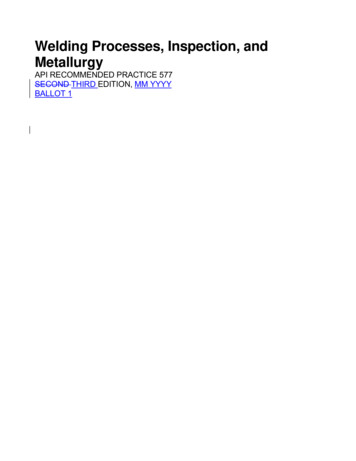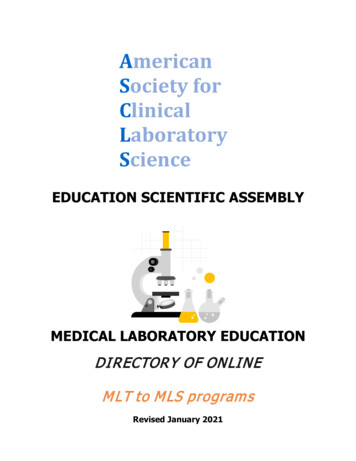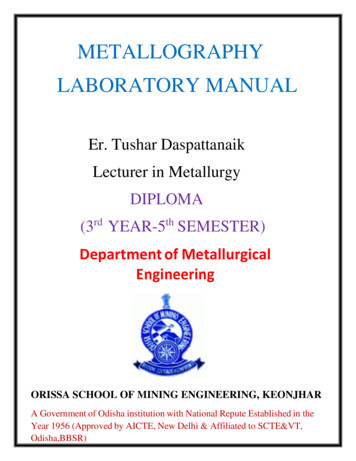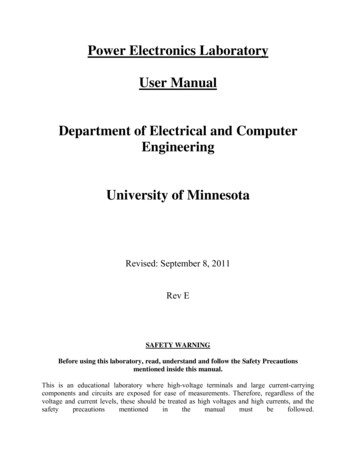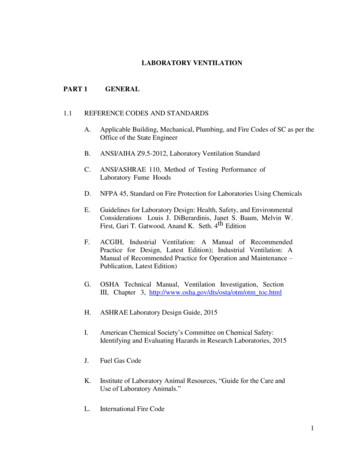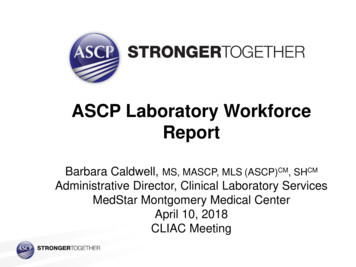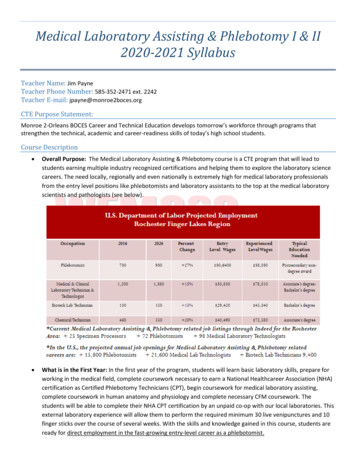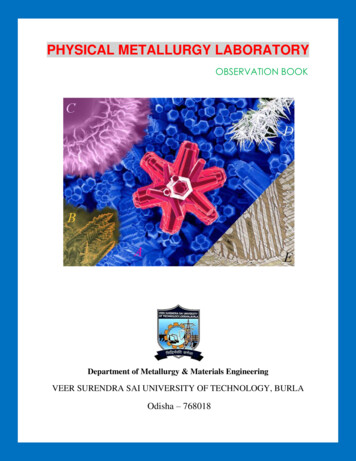
Transcription
PHYSICAL METALLURGY LABORATORYOBSERVATION BOOKDepartment of Metallurgy & Materials EngineeringVEER SURENDRA SAI UNIVERSITY OF TECHNOLOGY, BURLAOdisha – 768018
PHYSICAL METALLURGY LABORATORYOBSERVATION BOOKName of the Student: Scholar No: .LABOROTARY COORDINATOR(S)A. LAVA KUMARAssistant ProfessorSUBHADRA SAHOOAssistant ProfessorDepartment of Metallurgy & Materials EngineeringVEER SURENDRA SAI UNIVERSITY OF TECHNOLOGY, BURLAOdisha - 7680182
FOREWORDThis lab manual is designed to suit the needs of the under graduate metallurgist in acquaintingwith the principles and practices of metallography. The metallographic techniques are stressed,as these practices are essential for a metallurgist. In this observation book an attempt is made toclarify the concepts of crystal structures, specimen preparation techniques, etching techniques.The students shall get clarity about microstructures of carbon steels, cast irons and non-ferrousalloys, in particular to differentiate between various phases present in metals and alloys. Thestudent shall also be trained in grain size measurements, and quantitative metallography.Instructor will indicate the experiments to be conducted and advise on the nature of the lab reportand time of submission. However, a typical format for a lab report is included in this observationbook. It is important that all the information necessary to complete the lab report is obtainedbefore students leave the lab.Mr. A.Lava KumarAssistant ProfessorMs. Subhadra SahooAssistant Professor3
TABLE OF CONTENTSS.NoExperiment TitlePage NoSafety in the Laboratory5Log Book Mark Sheet81.Study of Crystal Structures through Ball Models92.Metallurgical Microscope: Principles and Operations163.Specimen Preparation techniques for Metallographic Analysis214.Fe-Fe3C Phase Diagram315.Microstructural Analysis of Carbon Steels376.Microstructural Analysis of Cast Iron507.Microstructural Analysis of Non-Ferrous Metals: Brass & Bronze638.Standard test Methods for Estimation of Grain Size70PROJECT : COLOUR METALLOGRAPHY784
SAFETY IN THE LABORATORYAll students must read and understand the information in this document with regard to laboratorysafety and emergency procedures prior to the first laboratory session. Your personal laboratorysafety depends mostly on you. Effort has been made to address situations that may pose a hazardin the lab but the information and instructions provided cannot be considered all-inclusive.Students must adhere to written and verbal safety instructions throughout the academic term.Since additional instructions may be given at the beginning of laboratory sessions, it is importantthat all students arrive at each session on time. With good judgment, the chance of an accident inthis course is very small. Nevertheless, research and teaching workplaces (labs, shops, etc.) arefull of potential hazards that can cause serious injury and or damage to the equipment. Workingalone and unsupervised in laboratories is forbidden if you are working with hazardous substancesor equipment. With prior approval, at least two people should be present so that one can shutdown equipment and call for help in the event of an emergency. Safety training and/orinformation should be provided by a faculty member, teaching assistant, lab safety contact, orstaff member at the beginning of a new assignment or when a new hazard is introduced into theworkplace.Emergency Response1. It is your responsibility to read safety and fire alarm posters and follow the instructionsduring an emergency2. Know the location of the fire extinguisher, eye wash, and safety shower in your lab andknow how to use them.3. Notify your instructor immediately after any injury, fire or explosion, or spill.4. Know the building evacuation procedures.Common SenseGood common sense is needed for safety in a laboratory. It is expected that each student willwork in a responsible manner and exercise good judgment and common sense. If at any time youare not sure how to handle a particular situation, ask your Teaching Assistant or Instructor foradvice. DO NOT TOUCH ANYTHING WITH WHICH YOU ARE NOT COMPLETELYFAMILIAR!!! It is always better to ask questions than to risk harm to yourself or damage to theequipment.Personal and General laboratory safety1. Never eat, drink, or smoke while working in the laboratory.Read labels carefully.2. Do not use any equipment unless you are trained and approved as a user by yoursupervisor.3. Wear safety glasses or face shields when working with hazardous materials and/orEquipment. Wear gloves when using any hazardous or toxic agent.4. Clothing: When handling dangerous substances, wear gloves, laboratory coats, and safetyshield or glasses. Shorts and sandals should not be worn in the lab at any time. Shoes arerequired when working with the heat treatment furnaces.5. If you have long hair or loose clothes, make sure it is tied back or confined.5
6. Keep the work area clear of all materials except those needed for your work. Extra books,purses, etc. should be kept away from equipment, which requires air flow or ventilationto prevent overheating.7. Disposal - Students are responsible for the proper disposal of used material if any inappropriate containers.8. Equipment Failure - If a piece of equipment fails while being used, report it immediatelyto your lab assistant or tutor. Never try to fix the problem yourself because you couldharm yourself and others.9. If leaving a lab unattended, turn off all ignition sources and lock the doors. Clean up yourwork area before leaving. Wash hands before leaving the lab and before eating.Electrical safety1. Obtain permission before operating any high voltage equipment.2. Maintain an unobstructed access to all electrical panels.3. Wiring or other electrical modifications must be referred to the Electronics Shop or theBuilding coordinator.4. Avoid using extension cords whenever possible. If you must use one, obtain a heavyduty one that is electrically grounded, with its own fuse, and install it safely. Extensioncords should not go under doors, across aisles, be hung from the ceiling, or plugged intoother extension cords.5. Never, ever modify, attach or otherwise change any high voltage equipment.6. Always make sure all capacitors are discharged (using a grounded cable with aninsulating handle) before touching high voltage leads or the "inside" of any equipmenteven after it has been turned off. Capacitors can hold charge for many hours after theequipment has been turned off.7. When you are adjusting any high voltage equipment or a laser which is powered with ahigh voltage supply, USE ONLY ONE HAND. Your other hand is best placed in apocket or behind your back. This procedure eliminates the possibility of an accidentwhere high voltage current flows up one arm, through your chest, and down the otherarm.Mechanical safety1. When using compressed air, use only approved nozzles and never directs the air towardsany person.2. Guards on machinery must be in place during operation.3. Exercise care when working with or near hydraulically- or pneumatically drivenequipment. Sudden or unexpected motion can inflict serious injury.Chemical safety1. Treat every chemical as if it were hazardous.2. Make sure all chemicals are clearly and currently labeled with the substance name,concentration, date, and name of the individual responsible.3. Never return chemicals to reagent bottles. (Try for the correct amount and share anyexcess.)6
4. Comply with fire regulations concerning storage quantities, types of approved containersand cabinets, proper labeling, etc. If uncertain about regulations, contact the buildingcoordinator.5. Use volatile and flammable compounds only in a fume hood. Procedures that produceaerosols should be performed in a hood to prevent inhalation of hazardous material.4. Never allow a solvent to come in contact with your skin. Always use gloves. Never"smell" a solvent!! Read the label on the solvent bottle to identify its contents.5. Dispose of waste and broken glassware in proper containers. Clean up spills immediately.6. Do not store food in laboratories.Additional Safety Guidelines1.2.3.4.5.6.Never do unauthorized experiments.Keep your lab space clean and organized.Do not leave an on-going experiment unattended.Never taste anything. Never pipette by mouth; use a bulb.Never use open flames in laboratory unless instructed by TA.Check your glassware for cracks and chips each time you use it. Cracks could cause theglassware to fail during use and cause serious injury to you or lab mates.7. Maintain unobstructed access to all exits, fire extinguishers, electrical panels, emergencyshowers, and eye washes.8. Do not use corridors for storage or work areas. Do not store heavy items above tableheight. Any overhead storage of supplies on top of cabinets should be limited tolightweight items only.9. Also, remember that a 36" diameter area around all fire sprinkler heads must be keptclear at all times.10. Be careful when lifting heavy objects. Only shop staff may operate forklifts or cranes.11. Clean your lab bench and equipment, and lock the door before you leave the laboratory.I Scholar No haveread and understood the laboratory safety procedures and policies. I am responsible forfollowing these procedures while in the laboratories.(Signature with date)7
PHYSICAL METALLURGY LABOdd semester 2015-16LOGBOOK MARK SHEETName:Section:Scholar Number:Group Number:TABLE OF CONTENTSS.NoMarks obtainedExperiment Title1.Study of Crystal Structures through Ball Models2.Metallurgical Microscope: Principles and Operations3.Specimen Preparation techniques for Metallographic Analysis4.Fe-C Phase Diagram5.Microstructural Analysis of Carbon Steels6.Microstructural Analysis of Cast Irons7.Microstructural Analysis of Non-Ferrous Metals8.Standard test Methods for Estimation of Grain SizeInstructor Sign./10./10./10./10./10./10./10./10PROJECT : Colour Metallography./20Total Marks obtainedUnauthorized absences will be credited with a mark of 0/10. Your completed laboratorylogbook (with this sheet firmly stuck in and fully completed) must be submitted to yourinstructor at the end of your each experiment. Your instructor will make a assessment andtransmit the mark.A. LAVA KUMARLaboratory CoordinatorSUBHADRA SAHOOLaboratory Co-coordinator8
EXPERIMENT 1CRYSTAL STRUCTUREObjective: To study the different crystal structures by using ball, ball and stick or wire models.Theory: Crystal structure is one of the most important aspects of materials science andengineering as many properties of materials depend on their crystal structures. The solid areeither crystalline or non crystalline. The majority of engineering materials, such as ceramics, andmost minerals, some plastics and all metals are crystalline in structure.9
Crystal structure: A regular and repetitious pattern in which atom or group of atoms ofcrystalline materials are well arrange themselves is known as crystal structure. All crystallinesolids may be classified into seven crystal systems or 14 crystal structures based on thesymmetry aspects.Symmetry: Symmetry refers to certain pattern or arrangement. A body is symmetrical when it isreproduced by certain operation. Symmetry operations are as follows: TranslationRotationReflectionInversionTable 1: The 14 Bravais lattices10
OBSERVATIONS1. Show the photographs of crystal structures what you made with the help of differentmaterials.11
2. Draw the possible void structures in B.C.C and F.C.C.Crystal structure of metallic element: Generally, the metallic elements crystallize mainly incubic structures.Body centred cubic structure (B.C.C.): Atoms are arranged at the corners of the cube withanother atom at the cube centre. Face centred cubic structure (F.C.C): Atoms are arranged at thecorners and centre of each faces of the cubic cell.Draw the BCC structure in the squaregiven below and show the tetrahedralinterstitial and octahedral interstitialsite.Draw the FCC structure in the squaregiven below and show the tetrahedralinterstitial and octahedral interstitialsite.CalculationsCalculationsNo. of tetrahedral sitesNo. of tetrahedral sitesNo. of octahedral sitesNo. of octahedral sites12
3. Identify the crystal structures and possible number of voids?Crystal structure:No. of tetrahedral sites:No. of octahedral sites:Crystal StructureNo. of tetrahedral siteNo. of octahedral site13
Answer the following Questions1. Define Crystal, Lattice and Motif.2. What is symmetry? What is the relation between symmetry and crystal systems?3. For a point at (xyz) show a translation, a reflection and an inversion operation.4. What is a unit cell? What is lattice parameter?5. What is Bravais lattice? How are the Bravais lattices obtained from the primitive cell?How many types of Bravais lattices are there?14
6. How many atoms are present in unit cell of BCC, FCC, HCP and Diamond Cubic?7. Define atomic packing factor. Obtain its expression for FCC?8. Why FCC metals are more ductile compared to BCC and HCP metals?9. Define linear density. and Planner density?10. What is the significance of this experiment? How is it related to your course of study?15
EXPERIMENT 2METALLURGICAL MICROSCOPEObjective: To study the components and functions Metallurgical Microscope.Optical microscopes are categorized on a structure basis according to the intended purpose. Anupright microscope (left photo) which observes a specimen (object to be observed) from above iswidely known as the most common type with a multitude of uses. An inverted microscope (rightphoto) which observes a specimen from beneath is used for observing the mineralogy andmetallurgy specimens, etc.16
Microscope Basic FunctionsAn optical microscope consists of the f
student shall also be trained in grain size measurements, and quantitative metallography. Instructor will indicate the experiments to be conducted and advise on the nature of the lab report and time of submission. However, a typical format for a lab report is included in this observation book. It is important that all the information necessary to complete the lab report is obtained

